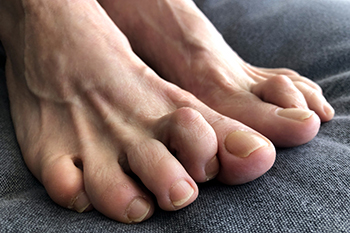
Hammertoe is a deformity that is usually found in the second toe. It is caused by an imbalance of the muscles, tendons, and ligaments that work together to make the toe straight. The result is that the middle joint of the toe raises up to form a peak, while the tip of the toe curls under. The type of shoes you wear, foot structure, and genetics all can contribute to the formation of a hammertoe. Women who wear high heels with pointy toes and children who wear shoes that are too short for their feet are more at risk of developing a hammertoe. Some people are simply born that way. Pain from a hammertoe occurs when the raised joint rubs against the inside of the top of the shoe. A corn or callus can develop, which may affect the gait and can increase pain in other parts of the foot and the body. A podiatrist can give you options for treating a hammertoe. Devices called hammertoe regulators can be custom fitted to help straighten the toe. Gentle exercises, such as picking up a towel with your toes can stretch and straighten the small muscles of the feet. In severe cases, surgery can be performed to permanently straighten the toe. For details on treatment options, please consult a podiatrist.
Hammertoes can be a painful condition to live with. For more information, contact one of our podiatrists of New England Foot and Ankle. Our doctors will answer any of your foot- and ankle-related questions.
Hammertoe
Hammertoe is a foot deformity that occurs due to an imbalance in the muscles, tendons, or ligaments that normally hold the toe straight. It can be caused by the type of shoes you wear, your foot structure, trauma, and certain disease processes.
Symptoms
- Painful and/or difficult toe movement
- Swelling
- Joint stiffness
- Calluses/Corns
- Physical deformity
Risk Factors
- Age – The risk of hammertoe increases with age
- Sex – Women are more likely to have hammertoe compared to men
- Toe Length – You are more likely to develop hammertoe if your second toe is longer than your big toe
- Certain Diseases – Arthritis and diabetes may make you more likely to develop hammertoe
Treatment
If you have hammertoe, you should change into a more comfortable shoe that provides enough room for your toes. Exercises such as picking up marbles may strengthen and stretch your toe muscles. Nevertheless, it is important to seek assistance from a podiatrist in order to determine the severity of your hammertoe and see which treatment option will work best for you.
If you have any questions, please feel free to contact one of our offices located in Chelmsford and Newburyport, MA . We offer the newest diagnostic and treatment technologies for all your foot care needs.
